I'm a suspension and alignment specialist and as such I do not get involved with lift kits or lowering kits. A very important part of my job is correcting ride height that is off as little as an inch from the design measurements. Lawyers and insurance investigators love to find those kinds of modifications so they can shift part of the blame away from the guy who ran the red light and caused a crash.
There are a number of things to consider when ordering replacement springs through the dealer. The two biggest factors are engine size and whether it came with air conditioning. Both of those affect the weight the springs must support. Even if you have a four-wheel-drive with a solid front axle, handling is affected by the added weight. With a heavier engine the stock springs are typically a little shorter but considerably stiffer to reduce body roll when cornering and diving when braking.
With the short-arm-long-arm suspension system, (upper and lower control arms), ride height has a major affect on tire wear. When old springs get weak and sag, the arcs the control arms go through changes due to changes in the suspension's geometry. You can have perfect numbers on the alignment computer but when that geometry is wrong, those numbers only pertain to a vehicle that is standing still, not bouncing up and down on the highway.
You also have to look at how the truck was raised. With a solid axle, all you can do is install taller springs or add a spacer to them. That will not alter the alignment but it will affect the relationship of the steering linkages to the wheels. A dropped pitman arm will reduce the error in the geometry but it still won't handle as well as it was designed to.
If you have upper and lower control arms and all that was done was to install taller springs, you and I have no idea what is going to happen. For sure handling will be miserable and tire wear will be greatly accelerated. The correct way to do it is to use "drop spindles". Those are spindles that put the center of the wheel, (the axle bearings), further down from the upper ball joint and closer to the lower ball joint. That does not alter the ride height of the suspension system. Ride height is not the same as the height of the body from the ground. Ride height has to do with the suspension system's geometry. Imagine driving onto a pair of 2" x 6" pieces of lumber. The body will be higher off the ground, but nothing changed with the suspension geometry.
Whatever is done with the pitman arm, the same thing must be done with the idler arm. Those two put the main steering linkage perfectly parallel to the ground. If that linkage is not parallel to the ground, the truck will dart from side to side when a tire hits any bump or hole in the road.
You also have to consider "scrub radius". Draw an imaginary line through the upper and lower ball joints. That line will intersect the road surface at a specific point on the tire tread. Altering ride height doesn't change scrub radius, but people usually raise their trucks so they can install larger diameter tires. That DOES affect scrub radius because it raises both ball joints while keeping the original angle. The larger the tires, the further out on the tread that line will hit the road. That's where the reduced handling and braking come into play that lawyers will use against you in the courtroom. They will convince a jury that you were less able to avoid that guy who ran the red light, and they will be right.
Drive shaft angle is another casualty of altering ride height. The motions the universal joints go through were carefully designed in to reduce wear and vibration.
Most trucks and minivans have height-sensing proportioning valves in the rear brake system because there can be such a wide range of loading in the rear from empty to fully-loaded. A one-size-fits-all proportioning valve like is used on cars would not meet all the different conditions. If nothing is done with that valve, it will always look to the braking system like there's no load in the rear so brake fluid pressure will be reduced to prevent easy rear-wheel lockup under normal braking. You can be sure the lawyers will see that.
As you can see there's a lot to consider when altering ride height or just installing different wheel or tires. The designers take this all into account when they design every car and truck. The braking and suspension systems work as a team. They are so well perfected that there isn't anything anyone can do later to improve those characteristics without at least degrading something else.
Monday, February 25th, 2013 AT 6:43 AM


